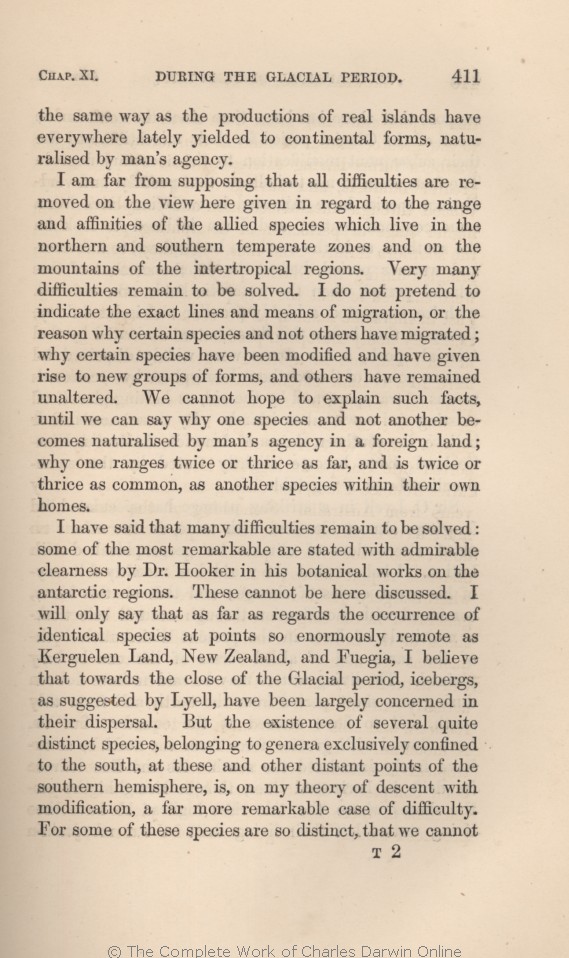the same way as the
productions | productions 1859 1860 1861 1866 | | inhabitants 1869 1872 |
| lately yielded to continental forms, 1859 1860 1861 |
| yielded to continental forms lately 1866 |
| yielded and are still yielding to continental forms 1869 1872 |
| by 1859 1860 1861 | | there through 1866 | | through 1869 1872 |
| man's 1859 1861 1866 1872 | | mans 1860 1869 |
| 2 blocks not present in 1859 1860 1861 1866; present in 1869 1872 | | The same principles apply to the distribution of terrestrial animals and of marine productions, in the northern and southern temperate zones, and on the intertropical mountains.
When
during the height of the Glacial period
the ocean-currents were widely different to what they now are, some of the inhabitants of the temperate seas might have reached the equator; of these a few would perhaps at once be able to migrate southward, by keeping to the cooler currents, whilst others might remain and survive in the cooler
depths,
until the southern hemisphere was in its turn subjected to a glacial climate and permitted of
their further progress; in nearly the same manner as, according to Forbes, isolated spaces inhabited by Arctic productions exist to the present day in the deeper parts of the temperate
seas.
|
|
|
I am
far | far 1859 1860 1861 1869 1872 | | very far 1866 |
| difficulties are removed on the view here given 1859 1860 1861 |
| difficulties 1866 1869 |
| the difficulties 1872 |
| range 1859 1860 1861 | | distribution 1866 1869 1872 |
| allied 1859 1860 1861 1866 |
| identical and allied 1869 1872 |
| species 1859 1860 1861 | | species, 1866 1869 1872 |
| live 1859 1860 1861 1866 |
| now live so widely separated 1869 1872 |
| northern 1859 1860 1861 1866 | | north 1869 1872 |
| southern temperate zones and 1859 1860 1861 |
| southern tem- perate zones and 1866 |
| south, and sometimes 1869 1872 |
| mountains of the intertropical regions. 1859 1860 1861 |
| mountains of the intertropical regions, are removed on the views above given. 1866 |
| intermediate mountain-ranges, are removed on the views above given. 1869 1872 |
| 3 blocks not present in 1859 1860 1861 1869 1872; present in 1866 | | It is extremely difficult to understand how a vast number of peculiar forms confined to the tropics could have been therein preserved during the coldest part of the Glacial period.
The number of forms in Australia, which are related to European temperate forms, but which differ so greatly that it is impossible to believe that they could have been modified since the Glacial period, perhaps indicates some much more ancient cold period, even as far back as the miocene age, in accordance with the recent speculations of certain geologists.
So again, as I am informed by Mr. Bates, the strongly marked character of several species of Carabus, inhabiting the southern parts of America, indicates that their common progenitor must have been introduced at some early period; and other analogous facts could be given.
|
| 1 blocks not present in 1859 1860 1861; present in 1866 1869 1872 | | The exact lines and means
of migration during the recent Glacial period
cannot be indicated;
nor the reason why certain species and not others have migrated; why certain species have been modified and have given rise to new nor the reason why certain species and not others have migrated; why certain species have been modified and have given rise to new groups of forms, and others have remained unaltered. others have remained unaltered.
|
| I do not pretend to indicate the exact lines and means of migration, or the reason 1859 1860 1861 |
| We cannot say 1869 |
| groups of forms, and 1859 1860 1861 |
| forms, whilst 1869 |
| man's 1859 1861 1866 1872 | | mans 1860 1869 |
| ranges 1859 1860 1861 | | species ranges 1866 1869 1872 |
|
I have said that many difficulties remain to be solved: some of the most remarkable are stated with admirable clearness by Dr. Hooker in his botanical works on the antarctic regions. These cannot be here discussed. I will only say
that | that 1859 1860 1861 | | that, 1866 |
| But the existence of several quite distinct species, belonging to genera exclusively confined to the south, 1859 1860 1861 1866 |
| The existence, 1869 |
| The existence 1872 |
| is, on my theory of descent with modification, a far 1859 1860 1861 |
| is, on the theory of descent with modification, a far 1866 |
| of species, which, though distinct, belong to genera exclusively confined to the south, is a 1869 1872 |
| case 1859 1860 1861 1866 | | case. 1869 1872 |
| of 1859 1860 1861 1866 | of 1869 1872 |
| difficulty. 1859 1860 1861 1866 | difficulty. 1869 1872 |
| For 1859 1860 1861 1866 | For 1869 1872 |
| some 1859 1860 1861 1866 | | Some 1869 1872 |
|









